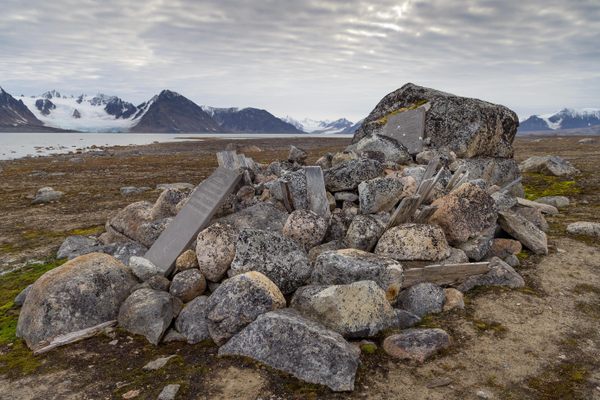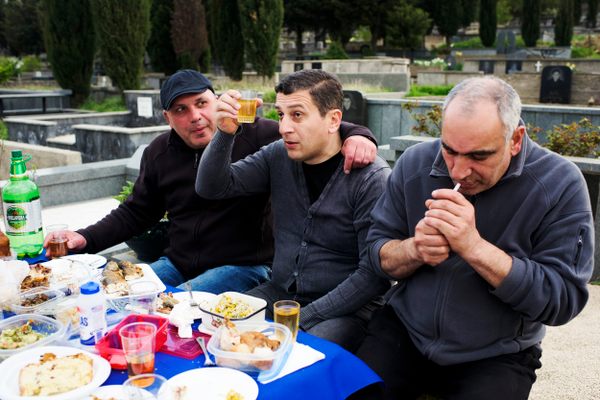Give My Body to the Birds: The Practice of Sky Burial
A vulture at a sky burial in 2013 for a Tibetan monk (photograph by Chensiyuan, via Wikimedia)
Sky burial isn’t a burial at all, of anything. It’s the act of leaving a corpse exposed to the elements, often in an elevated location, and only a few different cultures do it, for different reasons and in different ways.
The concept’s been on my radar for a few years thanks to happening upon the Vajrāyana Buddhist bya gtor practice primarily found in Tibet —and less so in China and Mongolia. It can be shocking to see — ex-human beings being dispassionately dragged up a mountain, chopped up, and thrown to a venue of waiting vultures.
But then I started to think (and read) about it. One of the main tenets of Buddhism is compassion, which includes kindness toward all animals. So the idea at work here is that, if your body is just a shell for your spirit, which will be reincarnated anyway, and if your spirit has left it and it could nourish another creature, then it should. Bya gtor literally translates to “alms for the birds” in Tibetan. It’s considered important to not waste the opportunity to help another living thing.
Sky burial site in Yerpa Valley, Tibet (photograph by John Hill)
A depiction of sky burials in Litang monastery (photograph by Antoine Taveneaux)
Once the body is kept in a sitting position for two days and a lama recites the necessary prayers, the corpse’s spine is broken so that it can be folded and carried to the sky burial site, which is usually quite a schlep. Family members may accompany the dead on this journey, beating double-sided drums and chanting. Once arrived at the site, the rogyapa, or body breakers, first burn juniper to attract vultures. The corpse is placed face-down on the stones, its hair removed, and the ropyagas begin to chop up the limbs with axes or sledgehammers, sometimes flaying meat from bones and throwing it to the waiting vultures.
When only bones remain, they’re pounded into a pulp, mixed with barley flour, tea, and yak butter, and given to the crows and hawks, after the vultures have had their fill of meat. It’s a bad omen if the vultures won’t eat, which can be a problem if the body has been treated with disinfectant or medicine, as it might be at a hospital. Typically, the yak that is used to transport the body is supposed to be set free after the ritual, which is yet another reason that sky burial can be a costly process. Most of the times that it’s practiced in Tibet, therefore, it’s a commuted version of leaving the corpse on the stones to be ritualized by the birds instead.
Sky burial is currently the preferred practice in Tibet when a loved one dies. Religion aside, a few other factors come into play here: generally, the soil in Tibet is a layer of permafrost only a few centimeters deep, and it covers solid rock, making it hard to dig. Wood is also difficult to come by, as most of Tibet is above the tree line, so cremation is a difficult process.
Zoroastrian Tower of Silence (photograph by Nick Taylor)
It was actually only around 40 years ago that a similar death ritual was performed by the Zoroastrians in parts of Iran and India. It differed in that the corpse was not prepared — it was left intact on a short tower with a low parapet around the perimeter (a dakhma, or “tower of silence”). On the top of the tower were concentric rings: the outer one for the bodies of men, the middle for women, and the innermost for children. When the sun had bleached the bones, which could take up to a year, they were collected and dissolved in lime in an ossuary pit at the center of the tower, then filtered by charcoal and flushed away by rainwater.
The Zoroastrians’ reasons for sky burial differed greatly from the Vajrāyana Buddhists. Zoroastrianism considers a dead body as unclean and impure, as well as liable to be rife with demons. To bury a body is to risk defiling the water supply via putrefaction, and cremating one could contaminate the air.
The use of dakhmas was outlawed in Iran in the 1970s, as the country’s urban limits spread out and threatened to swallow the rural areas where the towers are built. Many of these towers remain throughout Iran and India, along with the ossuaries where the bones finally rest. Today, in order to keep impurities and demons contained, some Zoroastrians have taken to encasing corpses in cement before they’re buried.
Zoroastrian dakhma in Mumbai, India (photograph by PP Yoonus)
In northern Australia, a ritual was practiced mostly in the north by various Aboriginal tribes wherein the bodies of the departed were placed on raised platforms and covered with foliage. After several months, when all of the flesh had been depleted, the bones were retrieved and painted red with ochre. Then they could be carried around by the deceased’s relatives, or placed in a cave until they degraded into dust, or stashed inside a hollow log, or just plain abandoned. For a period of time after the death, speaking the deceased’s name was forbidden, and his or her property would be destroyed.
Aboriginal burial platforms (Gutenberg, via American Indian History)
The concept was to avoid ghosts. These particular tribes believed that the human soul has two sections, and that one of them — the ego — is what returns as a ghost to haunt the tribe. So by destroying the deceased’s property and not acknowledging the person’s name, they would basically cold-shoulder the ghost out of town.
Funeral scaffolding of a Sioux chief illustrated by Karl Bodmer (via Wikimedia)
The Sioux and Lakota tribes of North America historically buried their dead, but practices varied among tribes and situations and sometimes included air burial, which utilized wooden scaffolds, or even the limbs of trees, in order to offer a corpse to the sky. The scaffolds were approximately eight feet tall and were traditionally constructed by women.
Oglala Sioux tree burial (via National Archives and Records Administration, College Park)
An Apsaroke burial platform (1908) (photograph by Edward S. Curtis, via Library of Congress)
This air burial was typically used for the bodies of warriors who fell in battle, and the favorite horse of the dead would often be killed and tied to the scaffold or tree by its tail. Bodies were wrapped tightly in blankets and with weapons and other valuables, and they could be left aloft for up to two years before being retrieved and buried, although this didn’t happen universally. The motive was not solely to encourage the dead person’s spirit to depart into the sky: Sioux and Lakota people feared the dead as well as the diseases they can spread, so it was also an attempt to minimize contact with the body.
Some tribes within Sac and Fox Nation of the midwestern United States would also place bodies in trees, and not necessarily the bodies of warriors, and sometimes there would be several “burials” per tree. Some tribes would often leave a slain warrior at the site of the battle that killed him, to decompose naturally, believing he would rise into the sky on his own (a different kind of sky burial, perhaps).
A vulture flying near a sky burial in Tibet (photograph by Lyle Vincent)
My research on the practice of deliberately not burying your dead more or less ended around here, although in looking at all the diverse rituals of sky burial, it is hard to contest with the directness of the Tibetan tradition where your human remains are fed right to the birds and taken in flight to the sky.
















Follow us on Twitter to get the latest on the world's hidden wonders.
Like us on Facebook to get the latest on the world's hidden wonders.
Follow us on Twitter Like us on Facebook